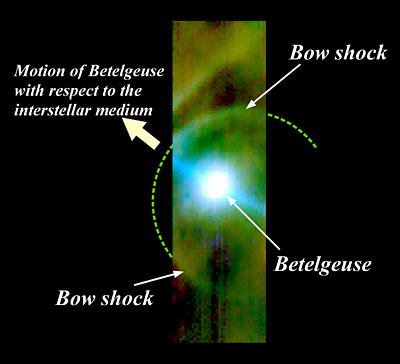[/caption]
You may be familiar with
Betelgeuse
, as it is the upper-left star in the constellation Orion, forming what would be his shoulder. But this is an image of Betelgeuse that you wouldn't see with your own eyes or even your own telescope. Images taken with the
Akari infrared telescope
show that as Betelgeuse travels through the interstellar medium, it creates what is called a "bow shock".
Betelgeuse (pronounced "beetle-juice", just like the 80's film starring Michael Keaton) is a red supergiant 640 light-years from Earth, and is located in the winter constellation Orion. It travels through the interstellar medium at 30 km/sec (19 miles/sec). It's not the star itself that creates the bow shock, but rather the interaction of the stellar wind emanating from Betelgeuse with the gas in the interstellar medium.
As Betelgeuse plows through the interstellar medium, the wind that it's spewing out at 17 km/sec (11 miles/sec) warms up the surrounding gas - which originates from star-forming regions in Orion's Belt - releasing light in the infrared. There is a rather strong current of interstellar gas in the area surrounding Betelegeuse, and just like the wave of water that is produced in front of a boat traveling over a lake, the dust and gas bunches up in front of Betelgeuse in the direction of travel.
[caption id="attachment_21335" align="aligncenter" width="400" caption="An artist's rendering of the bow shock created by Betelgeuse. Image Credit: ESA"]
[/caption]
The bow shock is approximately 3 light-years across, and the interaction it has with the stellar wind from Betelgeuse gives astronomers a better understanding of the density of the interstellar medium in the region, which in turn can help them get a better picture of the star forming regions in Orion's Belt that are the source of the gas.
If you turned your telescope towards the
Betelgeuse star
, you sadly would not be able to see the bow shock. Akari created the image using a composite of images taken at 65 (blue), 90 (green) and 140 (red) micrometers, well below what the human eye can see.
Source:
ESA
,
Bad Astronomy
 Universe Today
Universe Today
